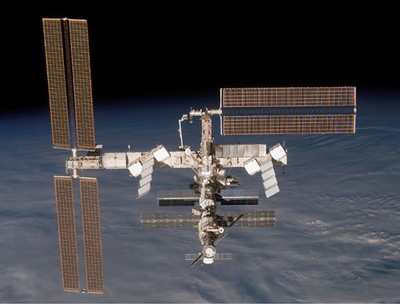Exploring The True Scientific Potential Of The ISS
 A September 12 signing of a
memorandum of understanding marked a key milestone for NASA and the
National Institutes of Health in their long partnership to advance
scientific discovery. The two agencies entered into an agreement
that helps American scientists use the International Space Station
to answer questions about human health and diseases. The pact
signals to researchers the availability of a remarkable platform on
which to conduct experiments.
A September 12 signing of a
memorandum of understanding marked a key milestone for NASA and the
National Institutes of Health in their long partnership to advance
scientific discovery. The two agencies entered into an agreement
that helps American scientists use the International Space Station
to answer questions about human health and diseases. The pact
signals to researchers the availability of a remarkable platform on
which to conduct experiments.
"The congressional designation as a national laboratory
underscores the significance the American people place on the
scientific potential of the space station," NASA Administrator
Michael Griffin said. "Not only will the station help in our
efforts to explore the moon, Mars and beyond, its resources also
can be applied for a much broader purpose -- improving human
health."
NASA sent Congress a plan in May describing how the US segment
of the International Space Station can be used as a national
laboratory. The report outlines possible partnerships with other
government agencies and private companies to conduct research
aboard the station. The signing marks the first such agreement
between NASA and another agency.
"I am extremely pleased that this collaborative effort is moving
forward," NIH Director Elias A. Zerhouni said. "The station
provides a unique environment where researchers can explore
fundamental questions about human health issues -- including how
the human body heals itself, fights infection or develops diseases
such as cancer or osteoporosis."
Compared with the Earth-bound laboratories where more than
325,000 NIH- funded researchers conduct experiments every day, the
facility at the station provides a virtually gravity-free
environment where the cellular and molecular mechanisms that
underlie human diseases can be explored.
Since the beginning of the space program, researchers have known
that prolonged periods of weightlessness cause bones and muscles to
deteriorate. The station provides a stable platform where
scientists can study the molecular basis of these effects for the
eventual benefit of people who suffer from weak, fragile bones or
muscle-wasting diseases.
Also, scientists know that when people escape the gravitational
pull of Earth, their brains also need to adjust to the sensation of
weightlessness. Understanding how in space parts of the brain
compensate for the absence of sensory input that gravity provides
on Earth holds promise for people who suffer from balance
disorders.
Other biologic systems in humans and in other organisms also are
affected by microgravity. A biologic explanation for observed
changes in microbe infectivity and human immunity during prolonged
space travel could offer new hope to people who have difficulty
fighting infections on Earth.

As part of the agreement, NIH and NASA will encourage
space-related health research by exchanging information and
providing technical expertise in areas of common interest. The
agencies will facilitate and share each other's research and
development efforts. In addition, NIH and NASA have agreed to
coordinate publicity of mutually beneficial activities,
publications and research results.
 Unfortunate... ANN/SportPlane Resource Guide Adds To Cautionary Advisories
Unfortunate... ANN/SportPlane Resource Guide Adds To Cautionary Advisories ANN FAQ: Turn On Post Notifications
ANN FAQ: Turn On Post Notifications ANN's Daily Aero-Term (04.29.24): Visual Approach Slope Indicator (VASI)
ANN's Daily Aero-Term (04.29.24): Visual Approach Slope Indicator (VASI) ANN's Daily Aero-Term (04.28.24): Airport Marking Aids
ANN's Daily Aero-Term (04.28.24): Airport Marking Aids ANN's Daily Aero-Linx (04.28.24)
ANN's Daily Aero-Linx (04.28.24)




